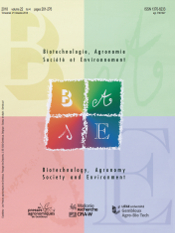Review policy
1. Checks and selection
Upon receipt of an article, the secretariat sends an acknowledgment to all the authors involved. If the manuscript is found to meet the criteria stipulated in these Instructions for authors (length, titles, illustrations, etc.) he is recorded. Otherwise, the secretariat requests additional information from the corresponding author.
It is then submitted to the copy editor. The copy editor checks the content of the manuscript. This first reading checks whether the manuscript is admissible. At this stage, the copy editor verifies the originality and the interest of the work, the structure of the manuscript, the ethical aspects and its scientific and editorial qualities.
Articles (in English) are submitted to an independent translation office in order to assess whether the level of written English is sufficient for the article to be considered for publication.
2. Validation
Manuscripts are then submitted to the editorial board. Articles deemed insufficient during the selection process are returned to their authors together with the justification for rejection.
Articles that are deemed admissible by the editorial board are sent to at least two reviewers (referees).
The editorial board reserves the right to select the reviewers from among its own evaluators or from the author's own suggested list. The peer reviewing is a “double-blind” process. Reviewers are not informed of the names or the affiliation of the authors, and nor do the authors know the identity of the reviewers. Nevertheless, a reviewer may accept to be contacted by the corresponding author.
The editorial board always takes care to avoid any conflict of interest between a reviewer and the authors of the article. The editorial committee avoids choosing reviewers who have close ties with one or more of the authors. In the case of a paper where at least one author is affiliated with the University of Liege or with the Walloon Agricultural Research Centre, the reviewers chosen would not belong to either of these institutions.
The editorial board reserves the right to reclassify the reviewers' decision. The decision made by the board will be one of the following:
- acceptance of the article
- a minor revision is required (editorial corrections)
- a major revision is required (fundamental corrections: objectives, experiments, results and interpretation, focus, etc.)
- rejection
The board’s decision is taken by majority of the members present. It will be notified to the corresponding author. He/she will receive the manuscript with comments and questions from the reviewers, inserted into the manuscript and/or provided separately.
A rejected paper cannot be resubmitted.
3. Revision
The time limit to return a corrected manuscript is two month. When the delay of two months is attained, he/she receive a recall message. If there is no reaction to this message, he/she receive a notification of rejection.
Changes in the manuscript should be introduced in a clearly identifiable manner: using “Track Changes" or a change of color. In the case of a major revision, it is requested that responses to comments and questions from the reviewers be provided in a letter accompanying the corrected article.
Revised manuscripts are reviewed and if necessary sent to the reviewers for re-evaluation. If the manuscript does not meet the recommendations of the reviewers, it will be returned to the author.
When the manuscript is accepted by the editorial board, it is passed on to the publisher. The corresponding author is informed by e-mail, with an attached license document to sign. At this stage, it is still possible that some questions may be sent to the corresponding author.
At the end of the publishing process, the secretariat sends the corresponding author a proof for final validation. The corresponding author must carefully review this proof. Minor corrections will still be accepted at this point. If the corrections required are substantial, or at the request of the author, a second proof may be submitted before final printing.

 Published in Open Access
Published in Open Access 



